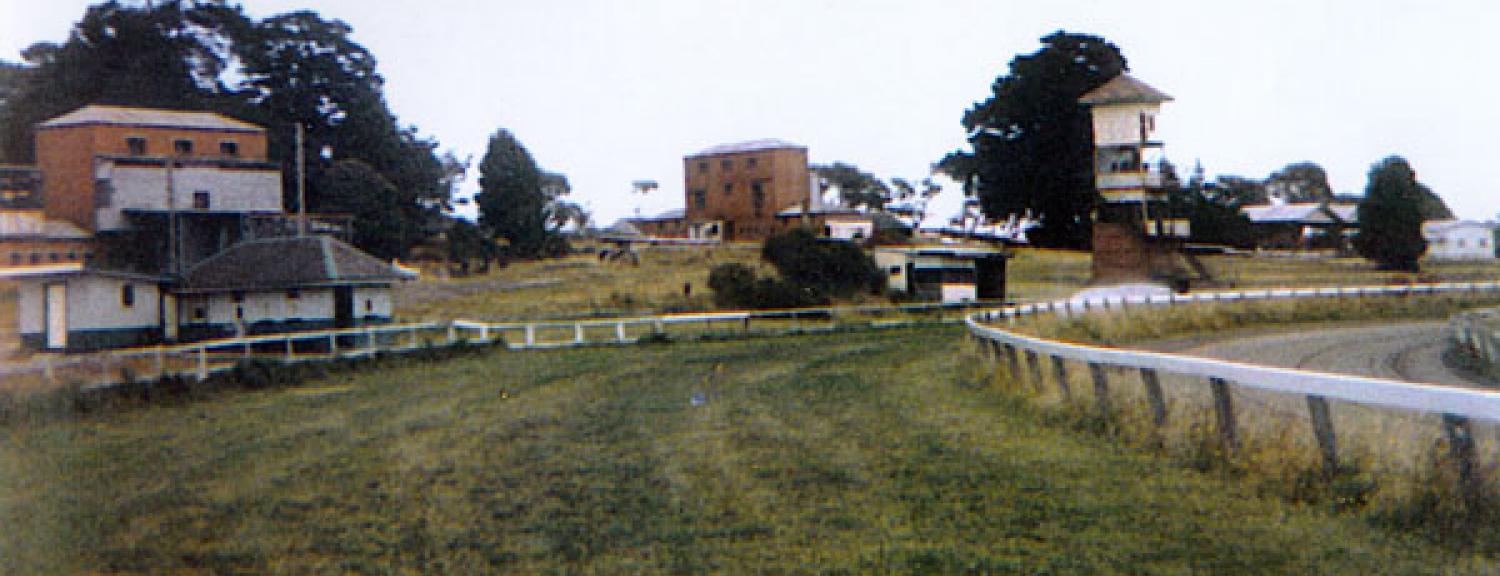Racing at Mentone & Jack Purtell
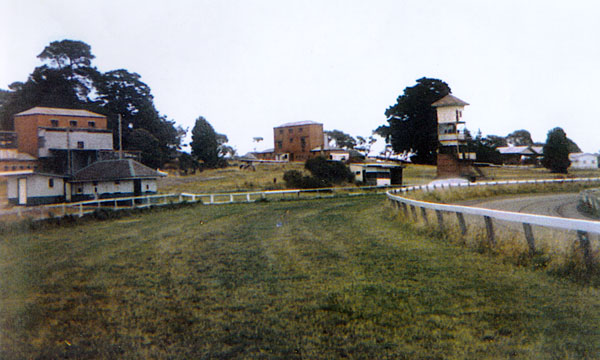
Mentone Racing Course showing track with judges’ box and buildings c1960.
Courtesy: Mordialloc and District Historical Society.
Jack Purtell was one of the many Mentone residents during and just after World War 2 who depended on horse racing to make a living. Jack rode three Melbourne Cup winners in the decade after Germany and Japan surrendered in 1945, so he was recognised as a top jockey, as well as being referred to as a champion sportsman of great integrity.
Born in 1921, Jack began riding at race meetings when he was just fifteen in 1936. At his third appearance in racing colours he booted home a winner. That first winner was Bonus at his home track, Mentone, in 1937. The Mentone course hosted regular meetings at that time. These meetings, along with those at Flemington, Moonee Valley, Caulfield and Williamstown were a normal part of the racing calendar at the time. If you met people when on bush holidays and said you were from Mentone, most would say, 'That's where the races are held'. In the 1940s there were many trainers around Mentone’s fringe. Local kids were used to admiring the big, well-groomed horses when the strappers took them for afternoon walks, allowing them to eat the nature- strip grass. We kids tried to guess the names of each horse. The strappers would never tell us whether we had the right names. Fred Hoysted was a top Mentone trainer. He and his sons, Bob and Bon, had several stable sites, Fred's being near the railway between Collins Street and Patty Street. Sid Ferguson trained horses with his base being next door to St Bede's in Palermo Street. There were several others but one was to become tops during World War 2. His name was Frank Manning.
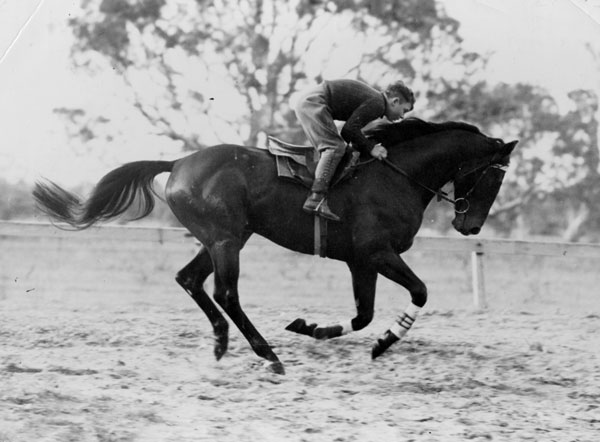
Racehorse at Braeside Park ridden by an apprentice.
Courtesy: Shirley Morgan, Kingston Collection, City of Kingston.
Not far from the Warrigal Road railway crossing, in Barry Street, Frank Manning had a very small set of stables behind his house. This place became famous in 1942. Cup Day that year was a very wet day as rain pelted down from early morning until well into the afternoon. Race Day went ahead despite the soggy track. Frank Manning had been assigned a rather ordinary galloper called Colonus which had not done much. However, he noticed that Colonus ran well when the rain fell and the track softened. The author of this piece lived a couple of streets away from Manning's stables and I recall that on the morning of the 1942 Cup the baker called at our place with a red hot tip. He told my parents that he had just delivered the bread to Manning's house and the trainer told him he had a 'mudlark', Colonus, that could win the Melbourne Cup that day. Whether my Dad backed it or not, I do not know, because off- course betting was illegal then, and he had to sneak down to the barber's shop where a bookie operated in an upstairs room. Of course, Colonus put on a great show. It jumped in front, was never headed, and won by eight lengths. It started at about 20/1 but earlier was double or triple those odds. Manning brought Mentone into the spotlight and boosted his own reputation which had not been brilliant up until then. Incidentally, Jack Purtell came in fifth on Gusher. Colonus was ridden by a young local apprentice, Harry McCloud. Mentone was suddenly in the headlines and the envy of neighbouring suburbs.
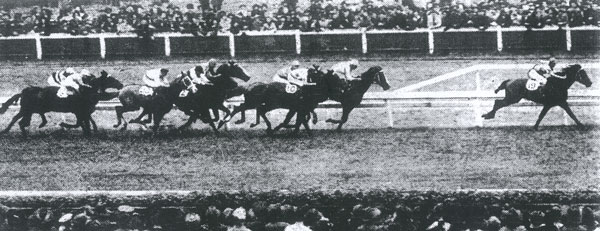
Colonus first time round in Melbourne Cup at Flemington leading the field.
Courtesy: Newspaper Collection, State Library of Victoria.
But Mentone was not established as a horse racing town, originally. The place was the centre of a land boom project set up by Matthew Davies, later Sir Matthew, in the early 1880s. When the railway reached Mentone in 1881 Davies built infrastructure in the town to attract land buyers to his land auctions. As a symbol of wealth and high living he built a coffee palace near the station. It had a grand Italianate tower that allowed visitors to view the bay and the surrounding open country. It is now Kilbreda College's signature building. Some mansions were also built for rich land boomers and a racecourse was opened in 1888 on the eastern fringe of Mentone, near Lower Dandenong Road. The racecourse was an added attraction to tempt land buyers. Grand race meetings took place involving local horses and others that were brought to Mentone Station in special trains and then walked to the track. The Mentone Cup each September became an important event and races continued at Mentone until Victorian racing authorities ceased holding official race meetings at the course. Williamstown and Mordialloc meetings were also discontinued as World War 2 raged in the early forties The Epsom course at Mordialloc became a training track, used by local trainers until the 1990s. Mentone's last meeting was in 1948 after which it also became a training track until sold for housing in 1972.
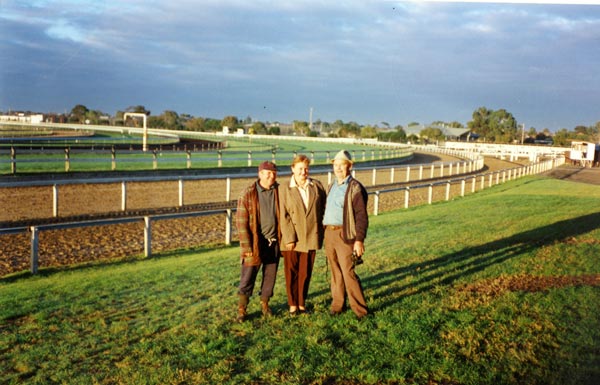
Epsom Racecourse. Eddie Laing, trainer with two friends.
Courtesy: Chilla Dow, Kingston Collection, City of Kingston.
During the period when Mentone's race track existed there grew a local fraternity of trainers, jockeys and others connected to the racing industry, including blacksmiths and farriers. Mentone race days were attended by an excited throng that poured out of the railway station and walked or took a cab to the course about half a mile away near Lower Dandenong Road. At Mentone railway station many horse cabs, small buses, hire cars and the odd four-horse drag waited in line to meet each Race Special as the trains were labelled. The punters boarded the many vehicles and there was a mad cavalcade as they raced each other up Balcombe Road towards the Main Gate of the racecourse. Out got the racegoers and then the cab horses were whipped for a speedy trip back to the station for the next train's racegoers. Later in the day as the last race approached the process was repeated, but in the opposite direction, as the punters headed back to the trains, mostly catching them at the upside platform that city-bound trains used. Mentone business owners enjoyed a lift in takings on race days and certainly would have been disappointed when the regular race meetings ceased.
Jack Purtell was born into this local racing society and knew this race day procedure very well. He lived on Lower Dandenong Road and then on Balcombe Road during his rise to the top of the industry as one of Victoria's most respected jockeys. Jack served his apprenticeship at the Ted Temby stables near the local course and his teenage years were spent grooming horses, cleaning stables and riding track work as dawn broke over Mentone's track, which was then surrounded by market gardens and grazing paddocks. He also began to show form as a jockey at Melbourne's main race meetings. He won the Williamstown Cup in 1940 and the Caulfield Cup in 1941. This gave him recognition as a top rider during the 1940s and 1950s as his success rate continued. He won the first of seven jockey premierships in 1946-7. Punters, trainers and owners liked the small trim man with the little moustache under his nose which was quite large and earned him the nickname of Schnoz, a comparison to the film comedian, Jimmy Durante, who had a similar nasal prominence. Of course, 'Purtell won by a nose' was a standard joke at the time.
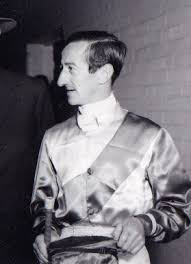
Jack Purtell at Flemington.
Courtesy: Australian Racing Museum.
It seems that Jack Purtell was specially respected among the racing public during his riding career and later. He was a quiet achiever. There are frequently occurring mentions of 'Gentleman Jack' in newspaper reports and other articles about his activities around horses and at the tracks. Jack was brought up in the Catholic faith and in the early 1940s he was often noticed walking to St Patrick's Church in Mentone on Sundays to attend Mass. After the Mass he was never surrounded by groups of men talking about racing; he just politely departed for home and a welcome rest from the demands of his public career. Jack relaxed by having hobbies away from the turf. One of these was stamp collecting.
When he married Norma in 1949 the reports confirmed that about seven thousand people turned up at the Clifton Catholic Church to get a glimpse of the popular sportsman. By then Jack was 28 and needed to continue his successful racing career to support a wife and possibly a family.
That career blossomed in the 1940s, especially after he rode Hiraji to win the 1947 Melbourne Cup. Hiraji was a grey horse, only the second one to win the Cup after Toryboy in 1965. Baghdad Note and Silver Knight in 1971-2 kept the greys' fortunes alive until Subzero's win in 1992. Hiraji was a well-performed horse but had a frustrating run of minor placings including second in the 1947 Caulfield Cup in the lead-up to the big one. In the Cup he hit the front at the top of the straight and held off Red Fury, the favourite. Reporters noted the broad smile on Purtell's face as he brought Hiraji to scale. In the small Riverina town of Carrathool where Hiraji had been bred, all the shops closed and the town's entire population spent the rest of the day and half the night in the pub. Jack Purtell had been riding for ten years, but the best was still to come.
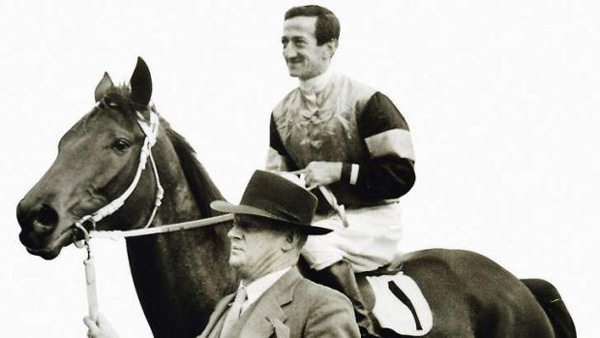
A Class Act. Jack Purtell won seven Melbourne Jockey premierships.
Courtesy: Sydney Morning Herald.
Hiraji's win propelled Purtell into the top group of Melbourne jockeys, along with Harold Badger, Bill Williamson, Ron Hutchinson, among others. He was sought after by top trainers and rode many winners. In 1953 Jack rode Wodalla in the Melbourne Cup. This horse had been disappointing its connections. It had started fifteen times for just one win and a few placings. However, Wodalla came good just as the Melbourne Cup neared. It won the Moonee Valley Cup and Purtell rode him cleverly to win the Melbourne Cup. Jack kept Wodalla just behind Hydrogen, the odds on favourite, and the two horses were still together at the turn. Down the stretch Purtell booted Wodalla to the front and passed Most Regal as Hydrogen dropped back to sixth, with Sydney's George Moore in the saddle. Wodalla did not win many other races, but he was one of only four horses to win the Moonee Valley-Melbourne Cup double. Early in the year of Wodalla's Cup Purtell had a serious fall in a Flemington race when his horse was nearly brought down and Jack was thrown in the air and skidded down the track, unconscious and seriously injured. He was rushed to the Alfred Hospital and the operation to cure a brain haemorrhage was touch and go. Mentone racing followers prayed that he would make it and he did, after a life-threatening battle for some days.
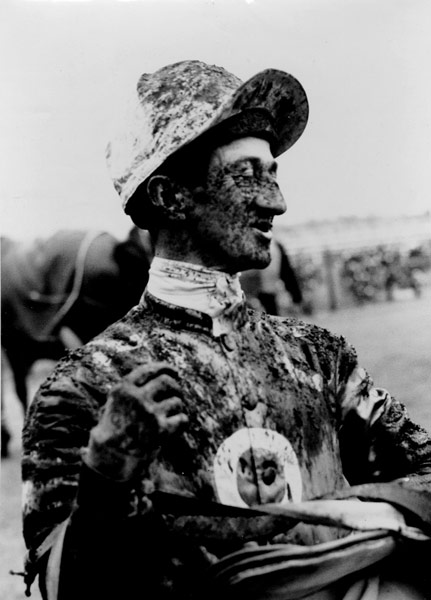
K613 Jack Purtell covered in mud after riding a horse trained by Ernest Willmott.
Courtesy: Shirley Morgan, Kingston Collection, City of Kingston.
Jack Purtell reached the zenith of his career when Rising Fast won the 1954 Cup, giving Jack two in a row. Champion jockey, Bill Williamson, was set to ride Rising Fast in the Melbourne Cup but was injured in a race fall on Caulfield Cup day. Rising Fast still won the Caulfield Cup under replacement jockey, Arthur Ward. In the Melbourne Cup Purtell replaced Williamson and kept Rising Fast among the forward group of horses until Gay Helios sprinted ahead at the turn. Purtell asked Rising Fast for a big surge and the gelding went on to win by a length and a half at odds of 5/2. This was Rising Fast's sixth win in a row. A year later the great stayer came second by less than a length in a bid to win three Melbourne Cups in a row, a feat no horse had achieved at that time.
During the latter half of the 1950s Purtell sought new places to test his riding skills. In 1957 he began to spend time in Europe. It took time to become a winner of the big races but in the early 1960s success came. Jack's wins in Britain and Europe included the Irish Oaks in 1964 and the English Oaks a year later.
Before branching out into European racing Purtell became part of Victorian turf history when he rode Fighting Force which was one of the horses in the Hotham Handicap triple dead heat in 1956. At the time no other triple dead heat had been recorded. Ark Royal (Reg Heather) and Pandie Sun (Bill Williamson) were the other horses that crossed the line locked together, unable to be separated by the photo finish technology that had been used since 1948. Jack thought Fighting Force had beaten Ark Royal but was not sure about Pandie Sun. When the judge declared the triple dead heat Jack simply recalls saying, 'Fair enough'. He made this remark when discussing the event during an interview when in his eighties. He also recalled the roar of the crowd when the dead heat was announced. Jack's mount, Fighting Force, was owned by K G Luke, later a president of the Carlton Football Club. He owned several other race horses and they all had FF as initials. Among them were Fine Fettle and Four Freedoms.
Perhaps Jack Purtell's strangest decision was when he asked Jim Cummimgs to release him from riding Comic Court in the 1950 Melbourne Cup so he could ride Alister, the Cox Plate and Victoria Derby winner. Purtell suffered interference on Alister in the Cup and Comic Court won with Pat Glennon very grateful to Jack for the chance to win the Big One. Purtell had been riding Comic Court in lead-up events and sometimes the horse pulled so hard that Jack's hands bled after the race. Later, Jack named Comic Court as the best horse he had ever ridden.

Jack Purtell with trainer Ernie Willmott, Mrs Eileen May and horse Durham.
Courtesy: Shirley Morgan, Kingston Collection, City of Kingston.
Jack Purtell finished race riding in 1970. By then he had ridden just over 1700 winners. After his riding career ended Jack became a stipendiary steward in the latter years of the 1900s. He retired to the Sunshine Coast in Queensland and died there at age 95 years on 8 March 2017. He is looked upon as one of the outstanding figures in Australian turf history.
